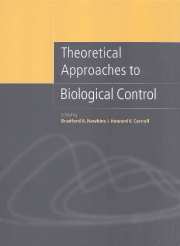Book contents
- Frontmatter
- Contents
- List of contributors
- Preface
- Part I Biological control theory: past and present
- Part II Ecological considerations
- Part III Spatial considerations
- 10 Dynamics of spatially structured spider mite populations
- 11 Habitat fragmentation and biological control
- 12 Outbreaks of insects: a dynamic approach
- Part IV Genetic/evolutionary considerations
- Part V Microbes and pathogens
- Index
12 - Outbreaks of insects: a dynamic approach
from Part III - Spatial considerations
Published online by Cambridge University Press: 13 August 2009
- Frontmatter
- Contents
- List of contributors
- Preface
- Part I Biological control theory: past and present
- Part II Ecological considerations
- Part III Spatial considerations
- 10 Dynamics of spatially structured spider mite populations
- 11 Habitat fragmentation and biological control
- 12 Outbreaks of insects: a dynamic approach
- Part IV Genetic/evolutionary considerations
- Part V Microbes and pathogens
- Index
Summary
Introduction
The basic premise of this chapter is that increased understanding of insect population dynamics will further our ability both to control and to predict the dynamics of insect pests (Metcalf & Luckmann, 1994). I will elaborate on this overall rationale below and will suggest approaches for achieving this goal. Mathematical models that can describe the dynamics of insects are vital for the design of effective control programs (Ruesink & Onstad, 1994). Yet, as I will argue here, despite much previous modeling of insect dynamics, further work is needed. Consequently, this chapter is much more prospective than retrospective.
As emphasized in Metcalf & Luckmann (1994), virtually all the theoretical underpinnings of insect pest control come from an equilibrium concept of insect population levels. In this vein, most analyses of host–parasitoid models used in biological control focus on the determination of the forces leading to a stable equilibrium, as an explanation for successful biological control. Similarly, the goal of biological control has often been stated to be the achievement of a stable equilibrium (Hassell, 1978). Yet, as many examples of forest insects (e.g., Berryman, 1988), plus essentially all insects affecting crops, show, equilibrium approaches are not at all appropriate when trying to understand the dynamics of many insect pests. Large departures from equilibrium, namely outbreaks, are the major features of interest in the dynamics of these insects. Thus, using an equilibrium concept as the central part of a theory to understand insect population dynamics is not appropriate.
- Type
- Chapter
- Information
- Theoretical Approaches to Biological Control , pp. 206 - 216Publisher: Cambridge University PressPrint publication year: 1999
- 2
- Cited by



